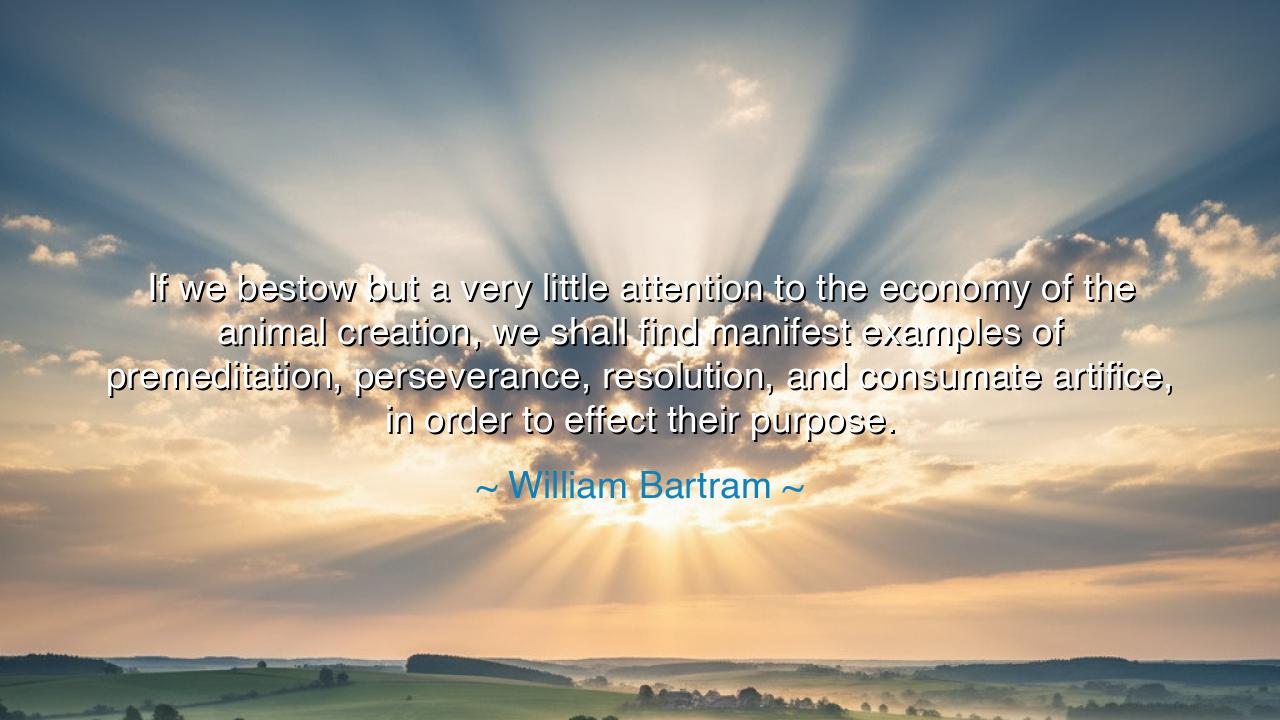
If we bestow but a very little attention to the economy of the
If we bestow but a very little attention to the economy of the animal creation, we shall find manifest examples of premeditation, perseverance, resolution, and consumate artifice, in order to effect their purpose.






In the wise and reverent words of William Bartram, the naturalist and explorer who wandered through the wild frontiers of early America, we find a truth both humbling and divine: “If we bestow but a very little attention to the economy of the animal creation, we shall find manifest examples of premeditation, perseverance, resolution, and consummate artifice, in order to effect their purpose.” Here, Bartram calls upon us to observe nature, not as masters looking down upon it, but as students sitting before a teacher older than time itself. He reminds us that the living world is not chaos, but order, not accident, but artistry—a vast symphony of intention and design, in which every creature plays its part with wisdom, discipline, and purpose.
Bartram lived in an age when the wilderness of the New World stretched unbroken for miles upon miles, untouched and untamed. As he traveled through forests and rivers, he saw that every living thing—from the eagle soaring above the pines to the ant laboring beneath the earth—carried within it an intelligence of being, a silent but powerful premeditation. The spider does not spin at random; the beaver does not build without foresight; the bird does not migrate without plan. Each creature, in its own way, reveals the eternal truth of perseverance—that life endures through purpose, and purpose endures through patience.
When Bartram speaks of resolution and consummate artifice, he honors not only the beauty of animal instinct, but its mastery. He saw in nature the same virtues that mankind so often claims for himself: determination, creativity, and the capacity to shape the world according to vision. The wasp that fashions its nest from earth and saliva, the bee that builds perfect hexagons of wax to store its honey, the salmon that travels from sea to river against impossible currents—all are living embodiments of resolve and artifice. They do not question, they do not despair; they act according to the deep rhythm that governs all life. To Bartram, such creatures were not lesser than man—they were teachers of order and intention.
Consider the beaver, that humble architect of the wild. With teeth and toil alone, it constructs dams that alter rivers and create new habitats. Its work shelters fish, birds, and plants, shaping entire ecosystems through its craft. To witness such labor is to see intelligence in motion—not human intelligence, but the deeper wisdom of nature’s design. The beaver’s perseverance is unbroken even by flood or frost. It rebuilds, it adapts, it survives. Is this not a lesson for humanity itself? For in its quiet way, the beaver teaches that steadfast effort, joined with understanding, can transform the harshness of life into harmony.
Bartram’s insight, though drawn from the 18th century, still rings true in our own age of haste and disconnection. We have grown so accustomed to our inventions that we forget the invention of nature itself—the sublime machinery of life that requires no factory, no engineer, no blueprint. We overlook the wisdom of the ant’s colony, the balance of the forest, the cooperation of the hive. Yet if we pause, as Bartram urges, and bestow but a little attention, we will see that the natural world embodies all the virtues that sustain civilization—discipline, foresight, artistry, and perseverance.
Indeed, Bartram’s words also speak to the human soul. For what are we, if not a part of the same economy of creation? In the ant’s diligence, we learn the value of labor; in the bird’s flight, the beauty of freedom joined with direction; in the wolf’s loyalty, the strength of community. To study nature is to rediscover ourselves, for its laws are written in the same essence that moves within us. The wise of all ages—from Laozi in the East to Emerson in the West—have echoed this truth: that nature is the first and greatest teacher, and that the one who learns from her lives with harmony, patience, and purpose.
So, O listener and seeker of truth, take heed of Bartram’s counsel. Go into the quiet places of the world and look with attention. Watch the spider spin, the bird build, the river carve its path through stone. In each, you will see premeditation, perseverance, resolution, and artifice—not as mere instinct, but as reflections of the eternal intelligence that binds all life together. Let these be your teachers, your mirrors, your guides.
And when you return to your own labors, remember the lesson of the animal creation: that purpose is born from patience, that mastery arises from repetition, and that beauty is the reward of perseverance. As nature builds through steady, humble work, so too must you shape your life—with care, with courage, and with devotion to the quiet art of doing well what must be done. In this way, you will walk in harmony with the world, and your deeds will join the great and endless design of creation itself.






AAdministratorAdministrator
Welcome, honored guests. Please leave a comment, we will respond soon